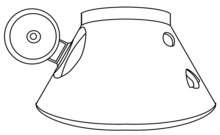


The Vozvraschaemyi Apparat (Russian: Возвращаемый Аппарат ВА, Return Vehicle, GRAU index 11F74), or VA spacecraft, was a Soviet crew capsule, intended to serve as a manned launch and reentry vehicle. Initially designed for the LK-1 manned lunar flyby spacecraft for one of the Soviet manned lunar programs, it was later repurposed for the Almaz military space station program.[6][1] The VA capsule on display at the Smithsonian National Air and Space Museum was labeled as Merkur, following a mistranslation of the original documentation – while incorrect, the name is being used in the West for the VA spacecraft and capsule.[4][5][7]
The VA spacecraft was capable of independent flight – up to 31 hours in its last incarnation – it needed however to be combined with additional hardware (containing propulsion and storage) to achieve a longer flight duration.[1] Three different such usage scenarios for the VA spacecraft were planed: Initially the LK-1 spacecraft, and after LK-1's cancelation the plans for Almaz APOS and the TKS spacecraft utilized the VA spacecraft.
- For the lunar flyby spacecraft LK-1, the plans by Vladimir Chelomey's design bureau OKB-52 were to mate an VA spacecraft together with an Equipment-Rocket System Block (PAB) and the Translunar Injection Stage (RB).[6]
For the Almaz program, the plans envisaged two configurations for the crewed VA spacecraft:
- An VA spacecraft would have launched the initial crew of a Almaz-OPS space station, the VA spacecraft launched together with the station itself; This combination was known as "Almaz APOS".[8]
- An VA spacecraft would have been launched mated together with an Functional Cargo Block (FGB) to resupply a Almaz station, in both crewed and uncrewed flights; This combination was known as the TKS spacecraft.[1]
While the VA spacecraft has seen some successful uncrewed test flights, both with and without an Functional Cargo Block, it never served in its intended role as a lunar or Almaz crew vehicle when the programs was canceled, and neither was it ever launched together with an Almaz space station.
Design edit
The VA spacecraft was initially designed as part of the LK-1 manned lunar flyby spacecraft, but got later repurposed for the Almaz space station program.
LK-1 – manned lunar flyby spacecraft edit
First work on the VA spacecraft had began on 13 May 1961 by Vladimir Chelomey's OKB-52 design bureau, in response to the US Apollo program.[6] The VA spacecraft consisted of three main parts:
- The VA capsule, which formed the pressurized habitable section for the crew
- The NO front compartment (Russian: Носовой Отсек НО, lit. "nose compartment"), housing the deorbit block (BSO), additional batteries, communication equipment, the parachute and soft landing engines[9][10][11]
- The SAS launch escape system (Russian: Система Сварийного Спасения САС) – similar to Soyuz and Apollo – mounted on top of the nose section, jettisoned after first stage had burned out[9][12]
Cosmonaut Alexei Leonov called the Almaz VA return capsule "our Apollo".[3] The shape of the VA capsule was vaguely like that of the Apollo Command Module (CM), however some of the VA's support hardware was housed on top of the capsule in the nose compartment – unlike Apollo with the Apollo Service Module (SM) below the Apollo CM.
While the VA spacecraft was capable of independent flight of about one day,[1] it needed to be mated to additional hardware for a longer flight duration. For a lunar mission, the LK-1 spacecraft would have been formed by mating the VA spacecraft with two components:[6]
- The Equipment-Rocket System Block (PAB). It included – analogous to the Apollo's SM – solar panels and electrical power systems, communications systems like a parabolic antenna and thrusters for midcourse maneuvers.
- And the Translunar Injection Stage (RB).
Specifications edit
LK-1 spacecraft edit
The LK-1 spacecraft included the VA spacecraft (see below), the Equipment-Rocket System Block (PAB) and the Translunar Injection Stage (RB).
- Diameter: 1 metre (3 ft 3 in)
- Height: 1 metre (3 ft 3 in)
VA spacecraft edit
The VA spacecraft included the VA capsule (see below) and the "nose section";[2] All data excluding TKS-FGB or Almaz-OPS.[1]
- Mass at launch (including launch escape system): 7,200 to 7,300 kilograms (15,900 to 16,100 lb)
- Gross mass: 3,800 kilograms (8,400 lb)
- Payload: 1,880 kilograms (4,140 lb)
- Diameter: 2.79 metres (9 ft 2 in)
- First flight: December 15, 1976, as VA spacecraft ("twin" solo flights Kosmos 881 and Kosmos 882)
- Last flight: September 27, 1985, as TKS spacecraft (Kosmos 1686)
VA capsule edit
- Total internal volume: 8.37 cubic metres (296 cu ft)
- Habitable volume: 4.56 cubic metres (161 cu ft)
- Diameter: 2.79 metres (9 ft 2 in)
- Reusable for 10 flights[3]
References edit
- ^ a b c d e f "TKS transport ship 11F72". RussianSpaceWeb.com. Retrieved 30 August 2012.
- ^ a b "TKS-VA (11F74)". Gunter's Space Page. Retrieved 1 September 2012.
- ^ a b c "TKS". Encyclopedia Astronautica. Retrieved 31 August 2012.
- ^ a b "Space Race". Smithsonian – National Air and Space Museum. Retrieved 1 September 2012.
- ^ a b "Merkur Capsule – Image Detail". Smithsonian – National Air and Space Museum. Retrieved 1 September 2012.
- ^ a b c d "LK-1". Encyclopedia Astronautica. Retrieved 2 September 2012.
- ^ "NASM: Nobody's Perfect". Almaz OPS-5 blog. Retrieved 1 September 2012.
- ^ "Almaz APOS". Encyclopedia Astronautica. Retrieved 31 August 2012.
- ^ a b "Другой корабль" (in Russian). Novosti Kosmonavtiki. Retrieved 2 September 2012.
The other spacecraft; The 25th anniversary of the first TKS flight
{{cite web}}: External link in|quote= - ^ "TKS BSO". Encyclopedia Astronautica. Retrieved 2 September 2012.
- ^ "TKS VA". Encyclopedia Astronautica. Retrieved 2 September 2012.
- ^ "TKS SAS". Encyclopedia Astronautica. Retrieved 2 September 2012.
